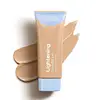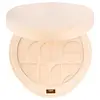What's inside
What's inside
 Key Ingredients
Key Ingredients

 Benefits
Benefits

 Concerns
Concerns

 Ingredients Side-by-side
Ingredients Side-by-side

Water
Skin ConditioningEthylhexyl Methoxycinnamate
UV AbsorberCyclopentasiloxane
EmollientButylene Glycol
HumectantIsododecane
EmollientCaprylyl Methicone
Skin ConditioningNiacinamide
SmoothingDimethicone
EmollientEthylhexyl Palmitate
EmollientLauryl PEG-9 Polydimethylsiloxyethyl Dimethicone
Skin ConditioningPEG-10 Dimethicone
Skin ConditioningTitanium Dioxide
Cosmetic ColorantStearic Acid
CleansingDimethicone Crosspolymer
Emulsion StabilisingSodium Chloride
MaskingTriethylhexanoin
MaskingZinc Oxide
Cosmetic ColorantDisteardimonium Hectorite
StabilisingSilica
AbrasiveCyclohexasiloxane
EmollientPropylene Glycol
HumectantPolyhydroxystearic Acid
EmulsifyingPhenoxyethanol
PreservativeDimethicone/Vinyl Dimethicone Crosspolymer
Skin ConditioningAloe Barbadensis Leaf Extract
EmollientPropylene Carbonate
SolventTriethoxycaprylylsilane
Aluminum Hydroxide
EmollientNylon-12
Tocopheryl Acetate
AntioxidantGlycerin
HumectantAllantoin
Skin ConditioningAscorbyl Tetraisopalmitate
AntioxidantEthylhexylglycerin
Skin ConditioningDisodium EDTA
Sodium Hyaluronate
HumectantBHT
AntioxidantTrimethylsiloxysilicate
EmollientGlycyrrhiza Glabra Root Extract
BleachingCarbomer
Emulsion StabilisingPolysorbate 20
EmulsifyingPotassium Sorbate
PreservativeSodium Benzoate
MaskingTocopherol
AntioxidantPalmitoyl Pentapeptide-4
Skin ConditioningCI 77891
Cosmetic ColorantCI 77492
Cosmetic ColorantCI 77491
Cosmetic ColorantCI 77499
Cosmetic ColorantWater, Ethylhexyl Methoxycinnamate, Cyclopentasiloxane, Butylene Glycol, Isododecane, Caprylyl Methicone, Niacinamide, Dimethicone, Ethylhexyl Palmitate, Lauryl PEG-9 Polydimethylsiloxyethyl Dimethicone, PEG-10 Dimethicone, Titanium Dioxide, Stearic Acid, Dimethicone Crosspolymer, Sodium Chloride, Triethylhexanoin, Zinc Oxide, Disteardimonium Hectorite, Silica, Cyclohexasiloxane, Propylene Glycol, Polyhydroxystearic Acid, Phenoxyethanol, Dimethicone/Vinyl Dimethicone Crosspolymer, Aloe Barbadensis Leaf Extract, Propylene Carbonate, Triethoxycaprylylsilane, Aluminum Hydroxide, Nylon-12, Tocopheryl Acetate, Glycerin, Allantoin, Ascorbyl Tetraisopalmitate, Ethylhexylglycerin, Disodium EDTA, Sodium Hyaluronate, BHT, Trimethylsiloxysilicate, Glycyrrhiza Glabra Root Extract, Carbomer, Polysorbate 20, Potassium Sorbate, Sodium Benzoate, Tocopherol, Palmitoyl Pentapeptide-4, CI 77891, CI 77492, CI 77491, CI 77499
Talc
AbrasiveMica
Cosmetic ColorantCaprylic/Capric Triglyceride
MaskingMagnesium Stearate
Cosmetic ColorantNylon-12
Triethoxycaprylylsilane
Phenyl Trimethicone
Skin ConditioningKaolin
AbrasiveSilica
AbrasiveDiisostearyl Malate
EmollientPhenoxyethanol
PreservativeChamomilla Recutita Flower Extract
MaskingChrysanthellum Indicum Extract
Skin ConditioningTocopheryl Acetate
AntioxidantArtemisia Argyi Leaf Extract
Skin ConditioningEthylhexyl Methoxycinnamate
UV AbsorberHamamelis Virginiana Extract
AntiseborrhoeicRosa Rugosa Flower Extract
Skin ConditioningRosa Rugosa Flower Oil
MaskingOryza Sativa Powder
O-Cymen-5-Ol
AntimicrobialAcetyl Hexapeptide-8
HumectantSqualane
EmollientEthylhexylglycerin
Skin ConditioningMethicone
EmollientCI 77891
Cosmetic ColorantCI 77492
Cosmetic ColorantCI 77491
Cosmetic ColorantCI 77499
Cosmetic ColorantTalc, Mica, Caprylic/Capric Triglyceride, Magnesium Stearate, Nylon-12, Triethoxycaprylylsilane, Phenyl Trimethicone, Kaolin, Silica, Diisostearyl Malate, Phenoxyethanol, Chamomilla Recutita Flower Extract, Chrysanthellum Indicum Extract, Tocopheryl Acetate, Artemisia Argyi Leaf Extract, Ethylhexyl Methoxycinnamate, Hamamelis Virginiana Extract, Rosa Rugosa Flower Extract, Rosa Rugosa Flower Oil, Oryza Sativa Powder, O-Cymen-5-Ol, Acetyl Hexapeptide-8, Squalane, Ethylhexylglycerin, Methicone, CI 77891, CI 77492, CI 77491, CI 77499
Ingredients Explained
These ingredients are found in both products.
Ingredients higher up in an ingredient list are typically present in a larger amount.
Ci 77491 is also hydrated iron III oxide. It's sole purpose is to give a red/pink hue to products.
Iron III oxides are classified as inorganic chemicals for coloring.
Synthetically created Ci 77491 is considered safer than those naturally found. This is because the synthetically created version may contain less impurities. Iron oxides are generally non-toxic and non-allergenic.
Learn more about CI 77491Ci 77492 is also hydrated iron III oxide. It's sole purpose is to give a yellow hue to products.
Iron III oxides are classified as inorganic chemicals for coloring.
Synthetically created Ci 77492 is considered safer than those naturally found. This is because the synthetically created version may contain less impurities. Iron oxides are generally non-toxic and non-allergenic.
Learn more about CI 77492Ci 77499 is also hydrated iron III oxide. It is created from mixing red and black iron oxides. This helps give shades of darkness to a product.
Iron III oxides are classified as inorganic chemicals for coloring.
Ci 77891 is a white pigment from Titanium dioxide. It is naturally found in minerals such as rutile and ilmenite.
It's main function is to add a white color to cosmetics. It can also be mixed with other colors to create different shades.
Ci 77891 is commonly found in sunscreens due to its ability to block UV rays.
Learn more about CI 77891Ethylhexyl Methoxycinnamate is an organic compound that provides UVB protection. It often goes by the more common name of octinoxate. It is created from methoxycinnamic acid and 2-ethylhexanol.
Ethylhexyl Methoxycinnamate absorbs UVB rays with wavelengths between 280-320 nm. UV absorbers protect your skin by using chemical reactions to convert UV rays into heat and energy.
UVB (290-320 nm) rays emit more energy than UVA rays. They are capable of damaging DNA, causing sunburns and are thought to be linked to skin cancer.
The state of Hawaii has banned sunscreens containing octinoxate due to its potential impact on coral reefs. More research is needed to bridge gaps in this research. The European Union allows higher levels of octinoxate in sunscreens than the US and Australia.
Ethylhexyl Methoxycinnamate is oil soluble. It is not stable and may lose efficacy when exposed to sunlight.
Learn more about Ethylhexyl MethoxycinnamateEthylhexylglycerin (we can't pronounce this either) is commonly used as a preservative and skin softener. It is derived from glyceryl.
You might see Ethylhexylglycerin often paired with other preservatives such as phenoxyethanol. Ethylhexylglycerin has been found to increase the effectiveness of these other preservatives.
Nylon-12 is a polymer. It is derived from 12-aminododecanoic acid, an omega-amino fatty acid
According to a manufacturer, it is a talc substitute. Like talc, nylon-12 gives products a satin feel. The manufacturer also claims this ingredients does not block pores and has moderate oil absorption.
This ingredient may not be reef-safe.
Learn more about Nylon-12Phenoxyethanol is a preservative that has germicide, antimicrobial, and aromatic properties. Studies show that phenoxyethanol can prevent microbial growth. By itself, it has a scent that is similar to that of a rose.
It's often used in formulations along with Caprylyl Glycol to preserve the shelf life of products.
Silica, also known as silicon dioxide, is a naturally occurring mineral. It is used as a fine, spherical, and porous powder in cosmetics.
Though it has exfoliant properties, the function of silica varies depending on the product.
The unique structure of silica enhances the spreadability and adds smoothness, making it a great texture enhancer.
It is also used as an active carrier, emulsifier, and mattifier due to its ability to absorb excess oil.
In some products, tiny microneedles called spicules are made from silica or hydrolyzed sponge. When you rub them in, they lightly polish away dead skin layers and enhance the penetration of active ingredients.
Learn more about SilicaTocopheryl Acetate is AKA Vitamin E. It is an antioxidant and protects your skin from free radicals. Free radicals damage the skin by breaking down collagen.
One study found using Tocopheryl Acetate with Vitamin C decreased the number of sunburned cells.
Tocopheryl Acetate is commonly found in both skincare and dietary supplements.
Learn more about Tocopheryl AcetateTriethoxycaprylylsilane is a silicone used to bind and stabilize ingredients.
As an emulsifier, it helps prevent ingredients from separating. This can help elongate the shelf life of products.
Triethoxycaprylylsilane is often used to coat mineral sunscreens ingredients to help give a better feel. It also helps reduce oxidative stress in sunscreens.
Learn more about Triethoxycaprylylsilane